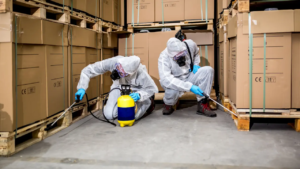Preventive measures are usually the best way to keep pests away. These include reducing food, water, and shelter sources and removing debris where pests may breed or hide.
Barriers, exclusion, and traps can also help keep pests at bay. For example, a sticky trap placed along a pest’s preferred route can catch it and deter it from returning. Contact Facility Pest Control now!

Prevention is the preferred method of pest control because it reduces the need for harmful chemicals and minimizes damage. It also allows time to correct environmental conditions that favour pest growth. Preventive measures may include removing conducive material, altering food sources, or improving storage methods. In some cases, a pest’s behaviour can be changed through manipulation or training.
Pests often invade homes and businesses primarily in search of food, shelter, or water. If left unchecked, they can cause considerable damage to buildings and their contents. They can also spread disease, contaminate food, and create fire hazards by chewing through electrical wiring. Preventing pest problems is far less expensive than repairing or replacing damaged goods and buildings.
Most pests have small, agile bodies that enable them to squeeze into the hardest-to-reach places. It is therefore important to keep areas clear of clutter, where pests might breed and hide. Regular rubbish collection and a well-maintained garden are also important preventive measures. In addition, it is important to know your local waste disposal day and to take care not to overfill garbage bins.
Physical controls include traps, screens, fences, walls and nets. Radiation, heat, electricity and chemical sprays sometimes are used to discourage or kill pests. Chemicals are generally only used when necessary, and they should always be applied carefully to avoid exposure of people and pets.
Biological control involves using a pest’s natural enemies, such as parasites, predators or pathogens, to limit its population. This method is sometimes referred to as “ecologically friendly” or “natural” control, although there can be a lag between the introduction of the enemy and the effect on the pest’s population. It is also possible to use sterilisation programs, where large numbers of sterile insects are released into the environment.
The most important consideration in managing any pest problem is to recognise when it has become a serious issue. Continual monitoring of the pest’s activity is essential to ensure that the appropriate control measure is in place and being effective. It is also vital to assess whether the harm caused by the pest is at an acceptable level.
Suppression
Many pests are a nuisance and cause damage that needs to be controlled. However, some pests may only be a problem in certain circumstances or at a small scale. In order to avoid the overuse of pesticides, growers and green industry professionals should use preventive tactics to keep pest populations from causing unacceptable harm. When necessary, they should also use suppression techniques to reduce pest numbers to an acceptable level or eradication methods to destroy the entire pest population.
Preventive tactics include frequently cleaning up areas where pests live, limiting their food sources, and keeping the environment unfavorable for their growth. Suppression tactics include reducing the availability of nutrients that promote pest population growth and controlling the activity of predators, parasitoids and pathogens that injure or kill them.
Some pest control problems are caused by weeds that compete with plants for water and nutrients. Using non-chemical means to remove or suppress these plants may be helpful. Other problems are caused by diseases that affect plants or insects. Diseases are caused by bacteria, fungi, viruses and protozoans that reduce the rate of growth and reproduction or cause death. Insects are also attacked by nematodes that, with their bacterial symbionts, infect them and cause disease or parasitism.
Several types of natural enemies, such as birds, amphibians and reptiles, eat pest insects. Other natural controls, such as topography and the presence of bodies of water, restrict pest movements and limit their breeding sites.
Chemicals such as fungicides, herbicides and insecticides can be used to control pests by directly attacking them or by making the environment unfavorable for their development. These chemicals are usually applied in the form of a spray, powder or granule.
Other organic or biological control agents injure, consume or parasitize pests to manage their populations. Some, such as the nematode Steinernema carpocapsae, are able to break down and ingest insect pests, poisoning them from inside out. Others, such as the bacterium Bacillus thuringiensis, are engineered into biological pesticides that are sprayed on plants or soil. When a plant ingests the bacterium, it releases toxic substances that inhibit the pest’s enzymes and impede growth or death.
Eradication
Pest control is the process of minimizing or eliminating unwanted organisms, whether they are insects, rodents, plants, or other animals. It is sometimes referred to as extermination, extirpation, or uprooting. Exterminate refers to the complete annihilation of an organism while extirpation means that the organism is driven from an area or region and can no longer survive. Uprooting is a more general term that can apply to the removal of an entire species or even a habitat.
Non-chemical methods can be very effective in controlling certain household pests, including most pantry pests (flour and grain beetles, meal moths, etc), some ants, and fabric pests (clothes moths, carpet beetles). Many of these techniques require diligent monitoring to ensure that the problem is effectively controlled. In addition, some of these non-chemical options offer the benefit of a lower risk of exposure to pesticides for family members and pets, especially when compared to chemical controls. In many cases, a visit from a professional pest control specialist is necessary to correctly identify the pest and suggest a treatment option.
Chemical pest control solutions can be more readily available and often deliver instant results. Some of these chemicals can be hazardous to people and the environment if improperly used, however, modern pesticides are generally designed to minimize this risk when compared to previous generations. Common examples of chemical pest control include repellents, which deter pests by delivering a scent or taste that is unpleasant to them, and insecticides, which kill insects by injecting them with poison.
In addition to using baits and traps, there are other types of chemical controls such as soil treatments that release substances that kill or deter pests. Generally, only qualified and certified pest control specialists should use these methods.
Another way to keep pests away is to eliminate their sources of food, water and shelter. For example, make sure to store food in sealed containers and remove garbage frequently, as well as to fix any leaks. Clutter can also contribute to pest problems, with stacks of cardboard and old newspapers providing warm and cozy homes for rodents and flies.
Monitoring
Pest control involves a range of activities that protect crops, buildings and public health. These activities include prevention, suppression and eradication. The methods used depend on the kind of pest and its impact. They may also vary according to the law, which can impact on what actions are taken and which products are used. For example, laws governing the use of pesticides may differ between countries.
The first step in a pest control plan is usually to identify the pest. This allows the pest to be classified and the best method of control employed. It is also important to know the pest’s life cycle and location. Accurate identification can help reduce the time and money spent on ineffective control measures.
When the pest has been identified, the next step in the process is to determine if it has reached an unacceptable level. This is called thresholding. This can be done by checking the pest population or examining the damage that has been caused. In addition, the pests can be monitored for signs of resistance to pesticides.
Businesses that prepare or serve food are particularly prone to pest infestations. In some cases, these pests can carry diseases that can threaten human health. As a result, they require rigorous hygiene standards and the services of a professional facilities management company.
Pests can be a major problem for businesses, affecting production and even damaging reputations. In addition, they can pose a threat to human health by spreading disease and contaminating food.
As such, pest control is an essential part of any business. In fact, many businesses have to adhere to strict legal regulations regarding their pest control strategies. This includes the prevention and eradication of pests, as well as regular inspections by a professional pest control expert.
Integrated Pest Management (IPM) is a strategy that uses both physical and chemical controls to prevent and manage pests. Its goals are to reduce the reliance on chemicals and to minimize adverse environmental effects. Control tactics can include crop rotation, introducing natural predators, pheromone traps and plant barriers.
